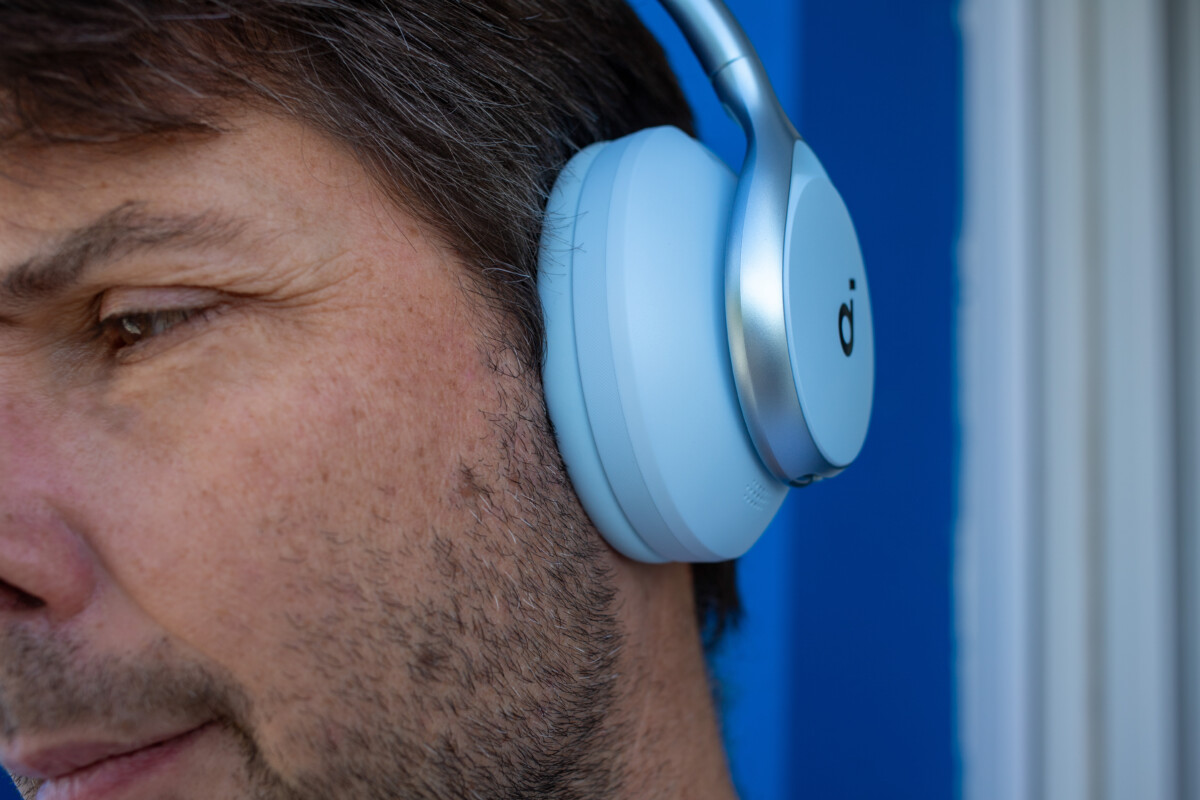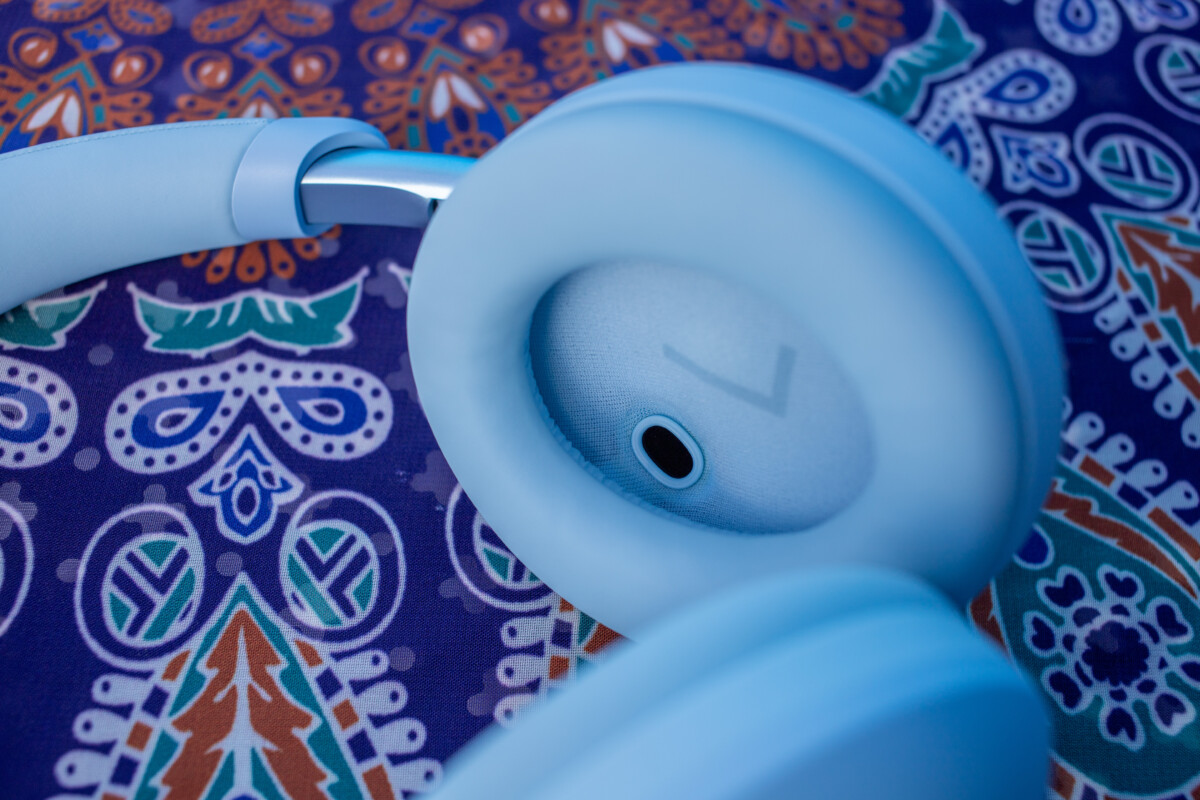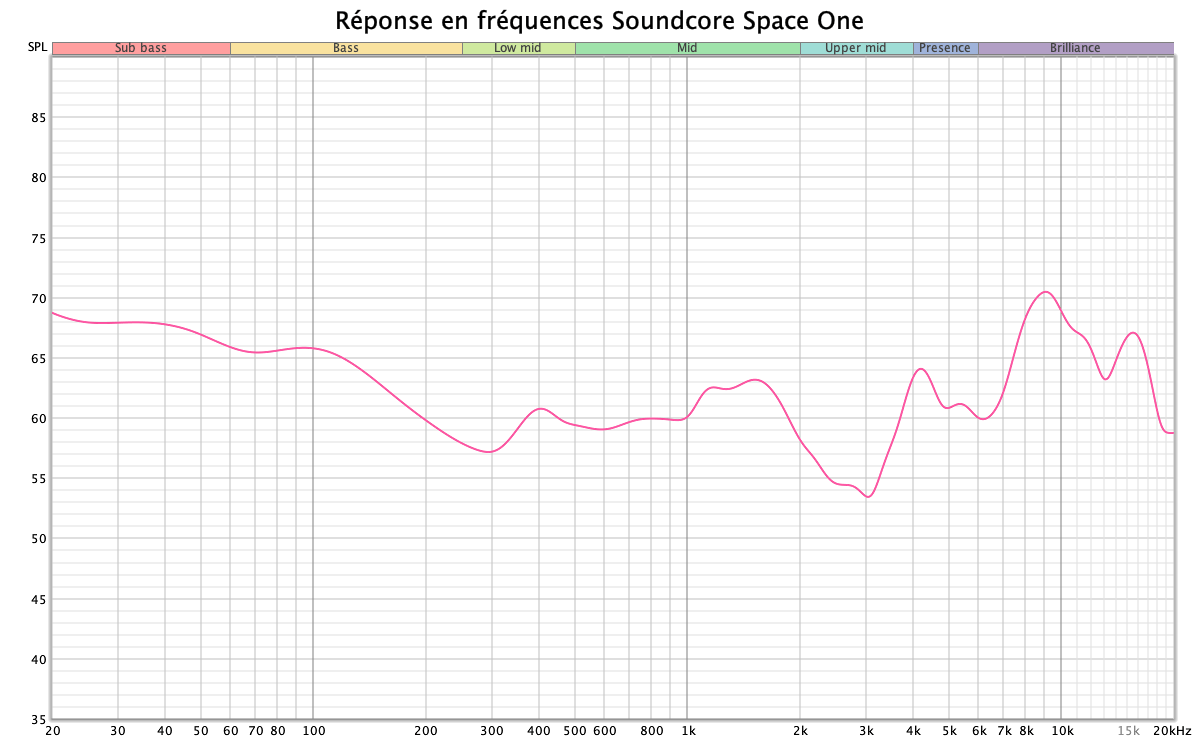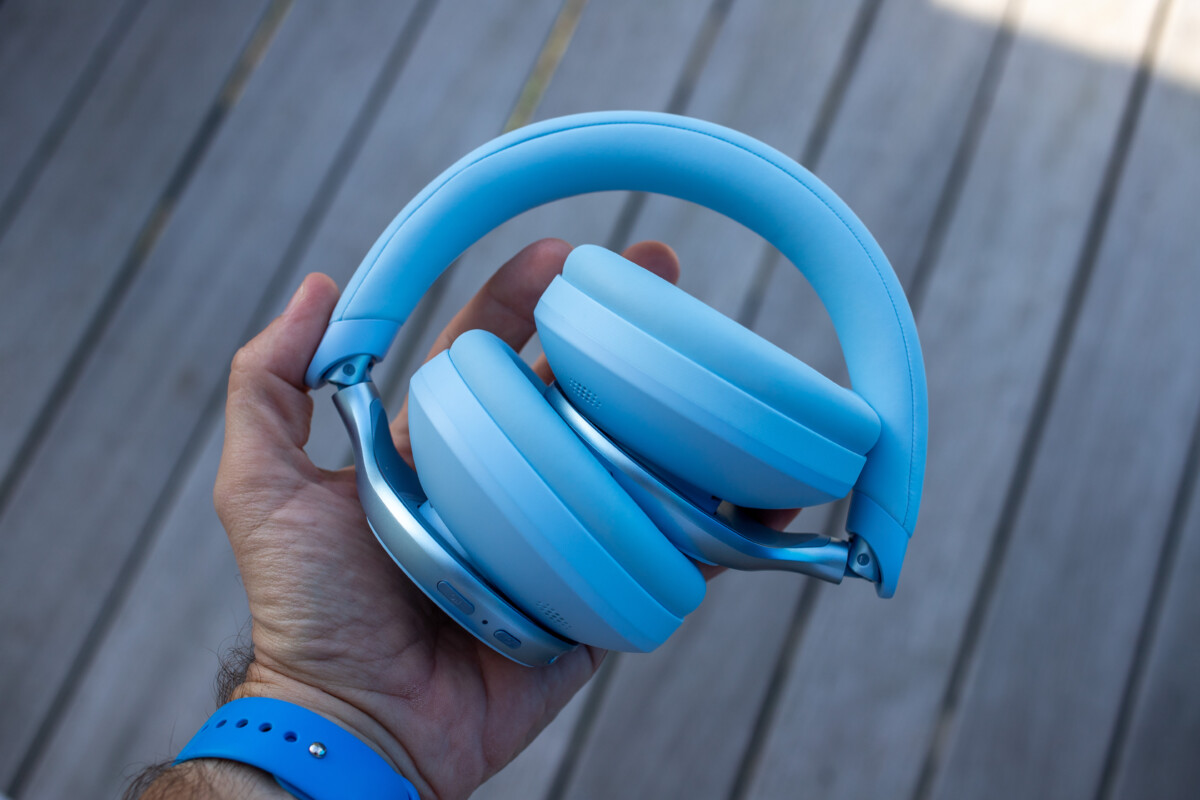Soundcore has not skimped on the specifications of the Space One, which has something to seduce on paper. HD sound, active noise reduction, adaptive sound, line input and long battery life are among the promises of the Chinese manufacturer Anker, which has already impressed in the past, notably with the Anker Soundcore Liberty 3 Pro headphones. Will he succeed again? Answer in this test.
Anker Soundcore Space One Technical sheet
This test was carried out with headphones loaned by Anker
Anker Soundcore Space One A soft and comfortable helmet
The Soundcore Space One is a particularly flexible foldable over-ear headset, almost entirely made of plastic. If the manufacturing quality seems generally correct, some details may attract suspicion, such as the play of the plastic buttons, which are also very slippery, or the approximate centering of the connectors. The materials used are not the finest, but obvious care has been taken with the different shades of blue of our test copy.
This headset stands out a little in the landscape of current audio headsets, because it is flexible and its earcups are articulated. In fact, it is very comfortable to wear, to the extent that it exerts very moderate pressure on the skull and is suitable for both small and large heads, but, on the other side of the coin, the inertia of the Space One is perceptible when rapid movements or walking with heavy steps. Its control buttons are distributed across the two shells, the one on the left receiving the power and noise reduction activation button, while the one on the right houses the volume control and playback buttons.

The USB-C charging connector is installed on the left earcup, alongside a 3.5 mm mini-jack socket which allows, with the cable provided, to use the line output of a portable music player or a computer, for example.
Anker Soundcore Space One Not all useful functions
The Space One headset is simple to use and its control buttons are easily identifiable under the thumbs. A downside all the same: the materials amplify and transmit to the ears the noises of contact and friction of the hands on the helmet. Clearly, there is not much insulation inside and what we listen to can also be heard through the shells.
To go further in using the headphones, you must use the Soundcore app which offers to configure the noise reduction button (ANC/transparency/normal) and possibly assign it an equalization profile to reinforce low frequencies by double press.
HearID Sound calibration is perplexing
SoundCore offers to measure your hearing acuity, in order to adapt the sound signature of its headphones to your ears. The process lasts a few minutes, during which you will have to click to confirm that you have heard — or not — each sound played. At the end of the test, a curve is displayed with the corrections applied. Problem is, the modifications take no account of the frequency response of the headphones; we will come back to this, but the treble is very forward and it is therefore not desirable to reinforce these frequencies.
However, this is what happened in my case, not hearing the last series of very high-pitched sounds, which I even doubt is really broadcast by the headphones, since a 10 year old child’s ears ” new » doesn’t hear them either.
An equalizer with many profiles
The Soundcore app has multiple equalization profiles (more than ten) to modify the signature of the headphones. It is also possible to create a personalized profile yourself with the 5-band equalizer. Still, its behavior is suspicious and the modifications I tried to apply were barely audible, or even ineffective. We can nevertheless calm the enthusiasm for Space One at the high end of the spectrum and, as we will see, it is far from useless.
Multipoint Bluetooth and Hi-Res Audio
The Soundcore Space One’s radio link is provided by a Bluetooth 5.3 chip, which supports a multitude of audio codecs as well as multipoint connection. You can therefore associate the headset with several sources and easily switch between two of them. The connection is perfectly stable up to 10 meters with an iPhone, through thin partitions and a wooden floor. However, the latency is noticeable and the sound lags behind the image in video games. No problem, however, when watching films or series, synchronization being ensured by the reading application.

Anker highlights support for many audio codecs, including Sony’s LDAC format accompanied by the Hi-Res Audio logo. On paper, the LDAC codec, which compresses sound a little less than traditional SBC or AAC technologies, is supposed to provide superior, even lossless, quality. This is not true and to be convinced, just use the Space One with its analog cable to see that there are more microdetails in the sound you listen to. In short, as always, you should not judge a headset by the codecs it supports, but only by the quality of its transducers.
Anker Soundcore Space One Too average noise reduction
Active noise reduction is adaptive, with five intensity levels adjustable manually or automatically, depending on ambient noise. However, whatever mode is chosen, its performance struggles to convince. This is partly linked to the low passive insulation, a consequence of the soft comfort of Space One, whose foams press very little on the skull. But the ANC’s digital processing of extraneous sounds is also too selective and only reduces the lowest sounds; all the others reach the ears without valid attenuation. In a crowded waiting room, it is impossible to listen to music at low volume without being disturbed by conversations or clear sounds around you (footsteps, door opening, etc.). It’s only in the car that the Soundcore Space One performs well, provided you close the windows. The wind noise reduction option offered in the app is also not effective.

Transparency mode lacks clarity and volume, despite, again, the ability to choose from five intensity levels. This is enough to hear cars approaching in the street, but not to hold a conversation in good conditions. It’s a shame, especially since the manufacturer has provided that the conversation mode can be triggered automatically when the user starts talking.
Anker Soundcore Space One Softness and lots of treble
The Soundcore Space One delivers a lively and lively sound, but strongly colored at the top of the spectrum with a predominance of the treble that the equalizer struggles to calm down. This can be pleasing, provided you are not looking for tonal accuracy for the instruments or overall neutrality. These headphones are easy to listen to, flatter the ear, but standardize everything you listen to to the detriment of artistic intentions. For example, Johnny Cash sounds roughly like 2Pac. There are also perceptible membrane colorations in the midrange (without harshness, however) and the whole sometimes lacks damping; It even sounds a little hollow. However, we must recognize a real softness in the sound.

Bass behavior is good, with generous volume and impeccable extension. The low-midrange is slightly recessed and this takes away a little depth from human voices. Further on, a small bump around 1 kHz brings presence, followed by a welcome dip around 2-3 kHz since this is precisely the range in which our ear naturally resonates and is hypersensitive. The high register looks like a Russian montage, with a huge peak of brilliance around 8 kHz, then a response around 15 kHz, a sign of good dynamic behavior.
- Severe: adequate muscle and extension
- Mid: voice a little thin and pinched, but no harshness
- Treble: too forward and bright, it colors and standardizes what we listen to.
Dynamic behavior and soundstage
The qualities of the Space One are more to be found in its dynamic behavior, which is really pleasant. The sound is nervous and full of energy. However, the tormented response at the top of the spectrum reduces the perception of small dynamic deviations. The spatialization of the sound is confusing: too much treble harms the soundstage and the different instruments and voices are flanked by a bright tone which prevents them from being properly superimposed. A happy mix in short.

However, Soundcore seems to have designed its headphones so that the sound remains ” from a distance » of the ears, which gives the restitution a certain airiness. In short, it breathes, but it’s not very well organized.
Anker Soundcore Space One Calls without filter
The quality of phone calls is the poor relation of Space One. If you are clearly heard by your interlocutor, it is only when you are calm. There is no ambient noise filtering system on this headset. The slightest stray sound is therefore captured and transmitted.
Anker Soundcore Space One Impeccable autonomy
The Soundcore Space One has gargantuan autonomy, announced at 40 hours ANC active and 55 hours without. I measured approximately 42 hours, active noise reduction at 50% volume, playing a playlist containing pop, jazz and rock tracks. This is excellent and a 5-minute charge when the headset is completely discharged is enough to restore 4 hours of battery life.
Anker Soundcore Space One Price and release date
The Anker Soundcore Space One headphones are available in black, cream and blue colors at a price of 99 euros.
Where to buy
Anker Soundcore Space One at the best price?
